 St. Patrick's Church
St. Patrick's Church
Exhibit Gallery












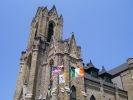









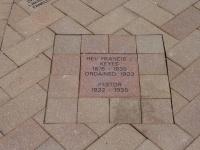












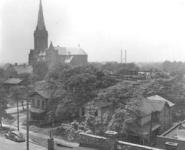

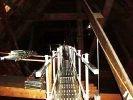









Essay and photographs by Gregory Johnson, 2007
Revised by Tamara Jones, 2012
This is a brief history, in both pictures and text, of the creation and renovation of the Historic St. Patrick's Church of Toledo. Archival footage courtesy of The Historic Church of St. Patrick's and the Toledo Lucas County Public Library. Special thanks to Mike Cora of the Toledo Lucas County Public Library and Deacon Thomas Carone of Historic Church of St. Patrick. All photos were taken by Greg Johnson, Digital Archivists at the University of Toledo, Ward M. Canaday Center for Special Collections.
Historic St. Patrick's Church in Toledo, Ohio has long been a staple of the skyline of Toledo. The church, with its roots dating back to the original St. Patrick's Church built in 1863, concluded a long renovation project with the Inaugural Organ Concert on October 23, 2007.
 Flags at the Historic St. Patrick's Church
Flags at the Historic St. Patrick's Church
This is a brief history, in both pictures and text, of the creation and renovation of the Historic St. Patrick's Church of Toledo. Archival footage courtesy of The Historic Church of St. Patrick's and the Toledo Lucas County Public Library. Special thanks to Mike Cora of the Toledo Lucas County Public Library and Deacon Thomas Carone of Historic Church of St. Patrick.
Early History of St. Patrick's Church
First Father of St. Patrick's Church, Father Edward Hannin (1826 – 1902)
The first pastor of St. Patrick's Church, Edward Hannin (Americanized version of the family name Hannan), was born into a relatively prosperous family in Emlanaughtan in 1826. Bartolomew and Margaret Tighe Hannin would have a total of eight children, although the family would also soon incorporate several of the local children through the school that they opened on their land.
Young Edward completed his early education at home and at the age of 19 set off for Dublin to complete coursework required for government employment. In 1846, Hannin took employ as a government engineer and superintendent of public works in Dublin. After a brief period in Liverpool working for a commercial house, Hannin, with the blessing of his parents, immigrated to the United States during the potato famine of 1849. He was 22 years old.
In America, Hannin soon became interested in working for the Catholic Church. After completing his studies in Greek and Latin, Edward entered the St. Mary's Theological Seminary in Cleveland under the sponsorship of Bishop Amadeus Rappe. Hannin joined the priesthood, after three years of study, in June of 1856.
Father Hannin's first appointment was as Assistant Priest to St. John's Cathedral in Cleveland. The following year, Hannin also took on the responsibilities of being the Secretary to the Bishop. After nearly six years of service, Father Hannin was given the chance to organize a parish in Toledo.
The Irish in Toledo in 1862 were a rough group, as most were employed as laborers building the canals and railroads that spurred the city’s boom. Along with this hard labor came even harder living, with saloons and other elements growing nearly as quickly as the population.
In April of 1862, Hannin set out to choose the site for his new parish, purchasing lots on the "highest point in the city" to build his new church. The land that would eventually become St. Patrick's Church was purchased in May of 1862 in an area of Toledo that would later be known as "Irish Hill," at the corner of Lafayette and Thirteenth Streets.
The cornerstone of the church was placed on July 4, 1862 by Bishop Luers of Fort Wayne, IN. The construction was quick, as the first mass was given on February 1, 1863. The final costs of construction of the first church, as well as its organ and church bell, would come to approximately $27,000.
Toledo in 1862
 Panoramic view of Toledo in the 1860s
Panoramic view of Toledo in the 1860s
To properly understand the hardships faced by Rev. Hannin and his young parish, one must know what Toledo was like in 1862.
When St. Patrick's held its first service in 1863, the city of Toledo was only three decades old and undergoing the usual growing pains of a young city. The city was looking to make its mark in the young nation as a transportation hub for the new northwestern portion of the country. The Middle Grounds area, land reclaimed from swampland between the Maumee River and Swan Creek, would become the railroad hub of the small city. By 1863, this area was home to the Island House Hotel, a stylish hotel built in 1856, as well as multiple grain elevators and most of the freight transfer in Toledo.
The city’s population had grown from 2,000 residents in 1835 to almost 14,000 in 1860. With this boom in growth came a need for infrastructure: the first sewer system (1848), a volunteer fire station (1837), Board of Education (1849), high school (1850), a volunteer police force (1852), gas lighting (1857), the Cherry St. Bridge (1865), horse drawn trolleys (1862), and telegraph service (1848). This growth and later industrialization would only continue following the Civil War.
Churches also boomed during this time period with the mission of trying to keep new male immigrants to the city out of saloons and taverns. The first church in Toledo, First Presbyterian (later congregational) was opened in 1833, with the first Catholic Church in Toledo, St. Francis de Sales on Cherry St., opening in 1841. Other Catholic Churches, such as St. Mary's German Catholic and St. Joseph's French Catholic followed, with St. Patrick's following in 1863.
The First St. Patrick's Church
 Church of the Immaculate Conception, AKA the Ballymote Church
Church of the Immaculate Conception, AKA the Ballymote Church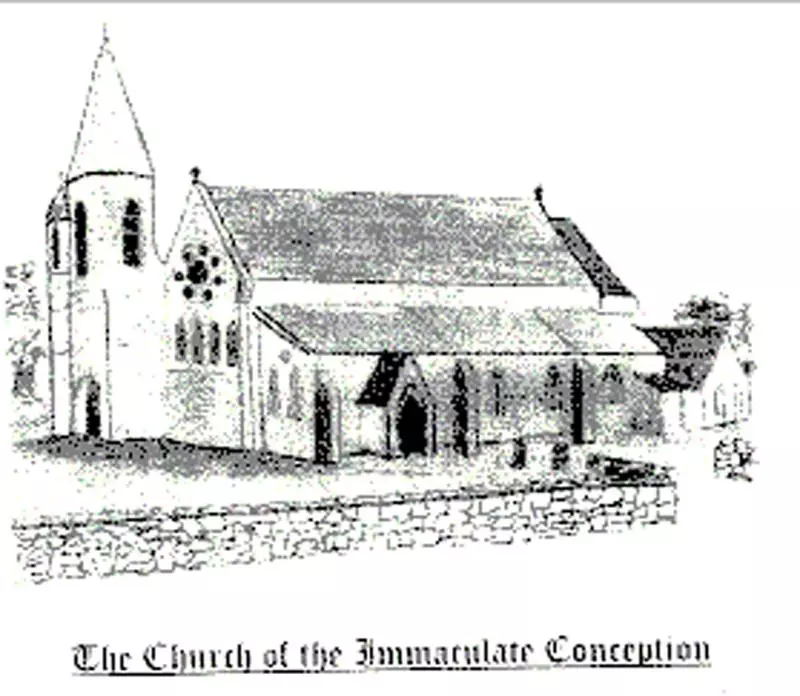 Drawing of the Church of the Immaculate conception
Drawing of the Church of the Immaculate conception
In 1864, as Father Edward Hannin was dedicating and beginning to lead St. Patrick's Church, his brother, Father Luke Hannin, was doing the same at the Church of the Immaculate Conception. The construction of the Church of the Immaculate Conception, sometimes called the Ballymote Church, began in 1857 and finished in 1864. The construction and dedication of the church was a family affair, as it was designed and built by another relative, Canon Denis Tighe.
In keeping with his upbringing, Edward Hannin wanted to institute an education system within his parish as soon as possible. Based on this desire, St. Patrick's Academy, a grade and two-year high school, was built in 1865. Father Hannin would also build a cemetery for the deceased of the parish, St. Patrick's Cemetery, and begin planning for a large diocese-wide Catholic Cemetery, which would become Cavalry Cemetery. Later innovative projects included the St. Patrick's Institute, a place where young men could gather in order to stay out of trouble with the law.
During the first 40 years of St. Patrick's, Hannin spent only a small amount of time away from the Church. With the resignation of Bishop Rappe in 1870, Father Hannin returned to Cleveland in the position of Administrator of the Dioceses until a new Bishop, Richard Gilmore, could be commissioned. In 1872, Hannin returned to St. Patrick's. After more than a decade of service, it seemed inappropriate for anyone else to lead the parish while he was physically able to. Recognizing this, Bishop Gilmore named Father Hannin Irremovable Rector of St. Patrick's Church in 1899.
Construction of the Current St. Patrick's Church (1892-1902)
The first incarnation of St. Patrick's Church, which was built in less than one year, began to show its age quickly. By 1891, after only 28 years of service, Rev. Hannin and the rest of the church deemed the church to be unsafe and decided to begin constructing a new building. Before demolition, the parishioners moved the organ, pews, and important artifacts out of the church and into the recently constructed parish hall. The first St. Patrick's Church was razed to make way for the current church that was built on the same lot.
 Cornerstone of the new St. Patrick's Church, laid on July 15, 1894
Cornerstone of the new St. Patrick's Church, laid on July 15, 1894
In May of 1892, the foundation for the new church was begun. Towards the end of 1892 and throughout 1893 and 1894, Hannin and the rest of the church leaders began the process of securing bids and selecting companies to work on the church.
The cornerstone of the new St. Patrick's Church was laid on July 15, 1894. The ceremony, which included a sermon by Rev. John Foley from Detroit, was conducted by Bishop Horstmann.
Based upon his reputation for excellent Roman Catholic churches, including past work on St. Michael's Church in Rochester, NY (the basis of St. Patrick's design), St. Mary's in Buffalo, NY, St. Joseph's in Pittsburgh, and Iglesia San Miguel (St. Michael's) in Cleveland, Adolphus Druiding of Chicago was selected to design the new church. Many of the churches built by Druiding, most in the classic gothic architecture of St. Patrick's, remain today. Druiding, known for his classical architectural ideas, was also known for his aggressive business style, which is evident in the letter between Druiding and Rev. Hannin during the planning, construction, and post construction period of St. Patrick's. A complete collection of the correspondence, contractor bids, contracts, and fundraising advertisements can be found at the Toledo Lucas County Public Library.
The construction of St. Patrick's spanned nearly a decade, with the first Mass celebrated on Christmas Day, 1900. Even though the physical form of the church was nearly complete, the planning for the dedication was just beginning. Rev. Hannin wanted Archbishop Ireland of St. Paul, Minnesota to give the dedication sermon.
 One of two gargoyles high above on the front facade of the church
One of two gargoyles high above on the front facade of the church
Archbishop Ireland, an incredibly busy man, originally had to turn down Rev. Hannin, stating that Hannin should look for a pastor closer to Toledo or from the East Coast. Undeterred, Hannin launched a massive campaign to convince Archbishop Ireland to give the dedication sermon. This campaign included letters of support from Mayor Samuel Jones, Judge J.A. Barber of the Common Pleas Court, J.W. Bloomer of the Toledo News, Robinson Locke of the Toledo Blade, Judges Hann, Parker and Lynn of the Circuit Court of Ohio, P.H. Dowling of Toledo Transfer Company, H.P. Crouse of the Toledo Times, and various Bishops from throughout Ohio. Hannin, in his letter to Archbishop Ireland, described the newly completed church as a "gem of gothic architecture” and one of the “most beautiful churches east of Chicago, if second to any it is only to St Patrick’s Cathedral in New York." In another letter, Mayor Samuel Jones described Rev. Hannin as a "monument to faithful and devoted life."
After seeing the outpouring of support for Rev. Hannin and St. Patrick's from all of the major figures of Toledo, Archbishop Ireland agreed to give the dedication sermon.
The official dedication of St. Patrick's occurred on April 14, 1901. The ceremony was attended by more than 100 religious leaders from all parts of the United States, including Cardinal Gibbons of Baltimore; Archbishop Martinelli, Papal Delegate at Washington; President of Washington University, Monsignor Conaty; the Bishops of Wheeling W.V.; Scranton, Pittsburgh, and Harrisburg, PA; and clergy members from Philadelphia and Brooklyn.
Passing of Father Hannin
 A brick in the Memorial Garden with Father Hannin's name inscribed
A brick in the Memorial Garden with Father Hannin's name inscribed
With the completion of his great church, Father Hannin began tending to the other needs of his parish. Knowing of his worsening health, various friends began the work of raising money to allow him to return to Ireland to rest. Hannin politely refused and never left his parish.
Father Hannin’s health began to fail during the final phases of the church’s construction. On November 7, 1902, he became ill during Mass at St. Patrick's. He was able to finish with the assistance of the altar boys who has been serving, but it would be his final Mass. Father Hannin passed away on the afternoon of December 14, 1902, immediately after receiving final absolution from Father Leahy.
After an ornate funeral service honoring his life and service, Father Edward Hannin was laid to rest in a mausoleum in Cavalry Cemetery. He was later interred in the family plot in the same cemetery.
Reconstruction of St. Patrick's Church
Early Renovations
The financial prosperity and growth of the city of Toledo during the early 1920s, which was felt by most of the country as well, did not reach St. Patrick's. With decreased attendance came financial woes. At the same time, the church was also in need of repairs. Father Keyes decided that the best way to fund these repairs would be by selling the now abandoned St. Patrick's Cemetery, which had been replaced as the resting place for the parish by Cavalry Cemetery.
 View of St. Patrick's Church in the 1930s
View of St. Patrick's Church in the 1930s
With this extra income, the renovation of St. Patrick's began. Changes included the marble floors that surround the altar and walls, new chandeliers and matching wall lights, and the addition of the signature shamrock inlays on the new terrazzo floors throughout the church. A new "Kilgen" organ was added to the choir loft, as well as new altar furniture. Outdoor improvements consisted of updating the front walkway, steps, and retaining walls. Other additions include the donated Stations of the Cross statues that adorn the church, which replaced pictorial representations.
In 1934, the church was the victim of vandalism. The vandals badly damaged the altar and stole various ornate gold objects. Most were recovered a few blocks away. Despite the vandalism, Mass was held the following Sunday.
In 1937, the last of the early renovations was completed as the cross on top of the spire was replaced due to damage. The new cross was made of wood and sheathed in copper and gold leaf. When completed, it was slightly smaller than the original galvanized steel cross that it replaced.
Renovation Projects, 1940s-2006
 View of St. Patrick's Church in the 1940s
View of St. Patrick's Church in the 1940s
There were various projects between the 1937 steeple cross replacement and the current major renovation of the church that attempted to keep the aging building as well-maintained as possible.
In what would prove to be a tremendous bargain, Monsignor Schmit discovered three slabs of marble in a local junkyard. Schmit was able to purchase the three slabs for a mere $21.00. They would become the altar currently in use at St. Patrick's Church. The altar would not go unscathed, as in 1974 a scaffolding set up to make emergency repairs to glass high above the church came crashing down on the altar.
 View of St. Patrick's Church in the 1940s
View of St. Patrick's Church in the 1940s
The 1980s found the church in financial crisis again. In 1984, the church created The Society for the Preservation of St. Patrick's Church in an attempt to bring back wayward parishioners and gain much-needed money for repairs. The society proved very adept at regaining lost parishioners, in addition to new members from Toledo’s Irish and Catholic communities. One of the first major repairs was to the church’s heating and cooling facilities, followed by the cleaning and restoration of the stained glass windows and updating of the nearly 100-year-old light fixtures. Later projects included remodeling the sacristy, removing pews at the rear of the church, restoring the louvers in the bell tower, and the construction of a new reconciliation room inside the church.
In 1972, the National Park Service added St. Patrick's Church to the National Register of Historic Places. In 1987, after years of controversy and various name changes, the name of St. Patrick's Church was officially changed to the Historic Church of St. Patrick. The name remains today. In 1991, the church was awarded a plaque of excellence by the Maumee Valley Historical Society for their continued efforts to maintain the church while "everything around it has been demolished or rebuilt."
History of the St. Patrick's Steeple
 View of the steeple after a lightning strike damaging it in 1980
View of the steeple after a lightning strike damaging it in 1980
The Historic St. Patrick's Church was originally constructed with a galvanized steel spire and steeple. Due to the height of the church, as well as the metallic covering of the newer cross, the landmark topping of the church was prone to lightning strikes. There have been at least four strikes, with the last recorded instance occurring in 1998.
A lightning strike in 1954 shorted out the electric organ. The next strike would prove to be the most catastrophic. On September 9, 1980, the cross at the top of the steeple was hit. When the lightning struck, the copper sheathing around the wooden cross fused the copper to the cross and a fire ensued. Due to the height of the steeple, the local fire department was unable to put out the fire before the steeple was completely destroyed. The fire department was able to minimize the damage to the church, however, and most of the destruction was limited to the steeple and the roof. The organ also suffered water damage.
After the most recent lightning strike in 1998, the church was retrofitted with a lightning protection system.
Following the 1980 fire, St. Patrick’s was without a steeple for almost a generation. In September of 2007, the steeple was re-attached to the church in a Skybreaking Gala.
2006-2007 Renovation Projects
After more than a century of service and ever-changing Toledo weather, St. Patrick's was beginning to show its age. Cracks were forming in the ceiling and on the walls, the brilliant stained glass windows were not as vibrant, and the many statues within the church were beginning to fade.
After discussion and debate in 2006, a full scale renovation of the church began. Almost every single aspect of the church, both inside and out, was to be renovated or improved. The majority of the funding was provided by the estate of Margaret Kennedy Hays Tank, a lifelong parishioner who passed away in 2006. A statue in her honor was placed in the Memorial Garden next to the church.
On June 10, 2007, a Mass of Thanksgiving was given to celebrate the restoration of the church. In September of that year, St. Patrick’s held a Mass of Thanksgiving to commemorate the firefighters who fought the 1980 fire. Leonard Blair, Bishop of Toledo, presided over the Mass, which included a full choir; harpist (Denise Grupp-Verbon); the Academy Brass Quintet; the Church Organist (Terry Brassell); as well as Pipes and drums bagpipers from the Toledo Fire Fighters. A "skybreaking" was held on September 15 of that year to celebrate the return of the steeple to the historic church. The organ was blessed in a Mass held on October 21, and the inaugural organ concert was held on October 23.
Below are pictures of the renovations.
St. Patrick’s had been without its signature steeple for almost 27 years when a replacement was set atop the church on September 6, 2007. It was built by Campbellsville Industries – the self-proclaimed "steeple people" – of Campbellsville, KY. The steeple measures more than 89 feet in height and weighs almost 12 tons. Including the cross at the top, the church is almost 250 feet tall and is easily recognizable from freeways, streets, and areas outside of the city.
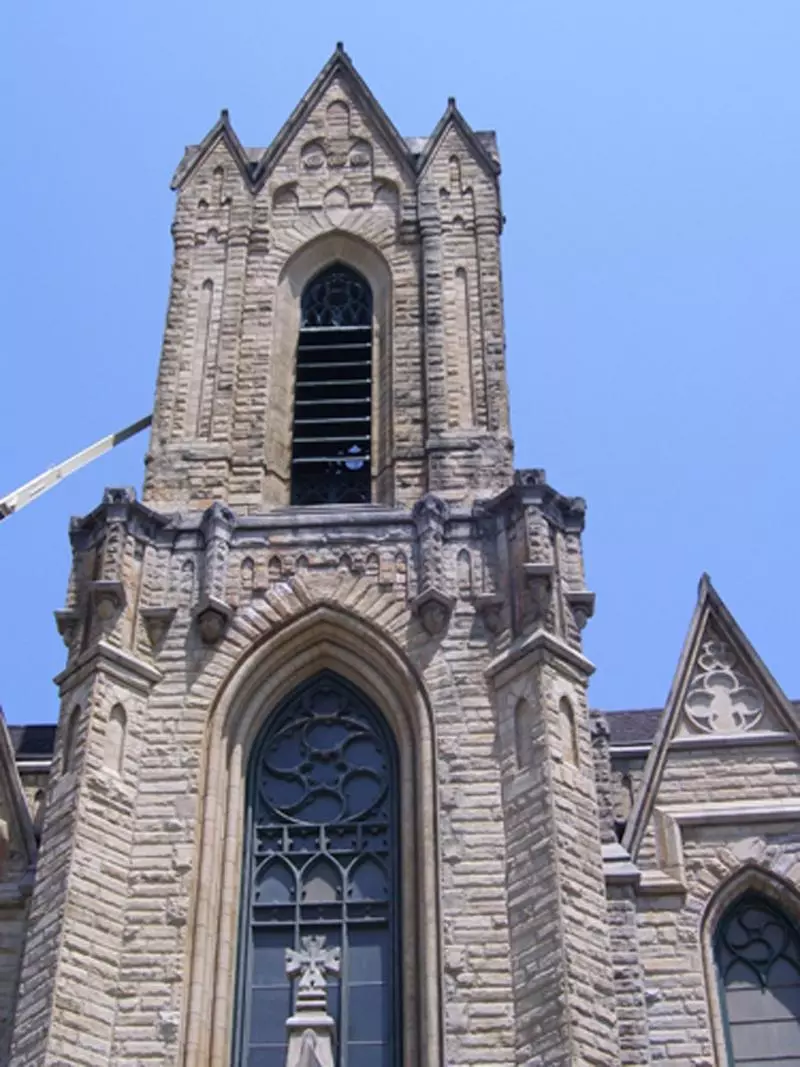 St Patrick's without the steeple
St Patrick's without the steeple St. Patrick's after the steeple reinstalled
St. Patrick's after the steeple reinstalled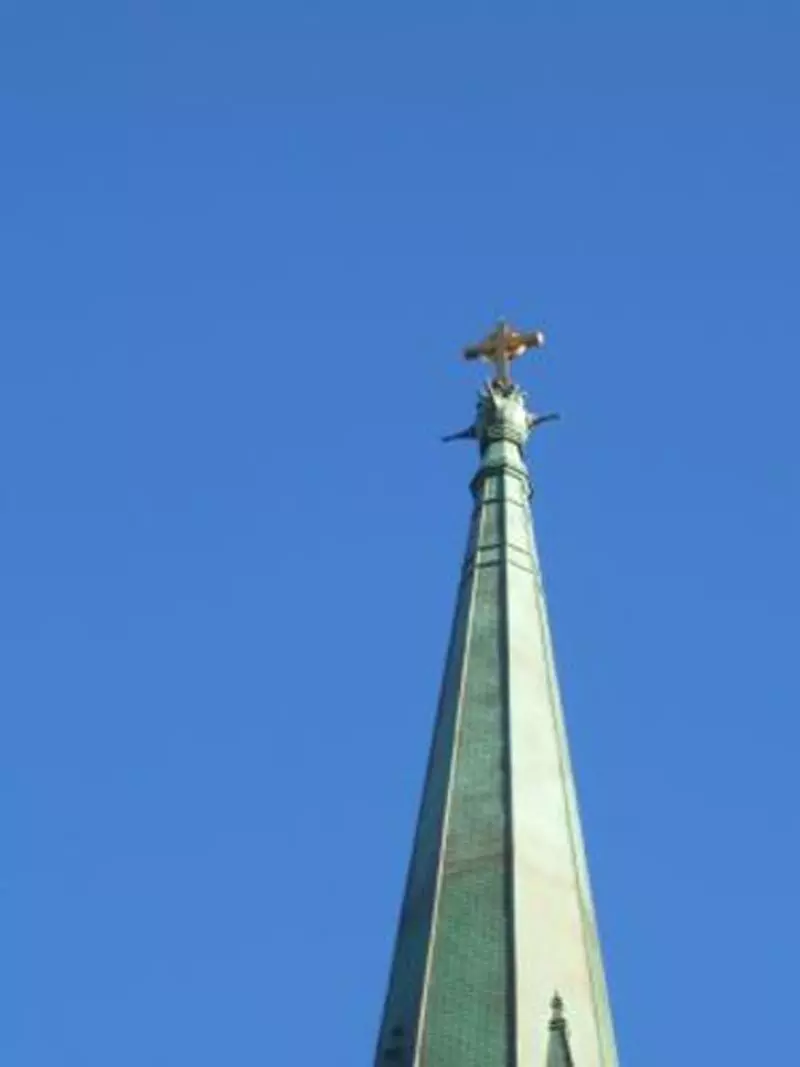 New steeple with the aged finish
New steeple with the aged finish
The new steeple was given an "aged" finish so that it would not stand out from the 105-year-old monument built by Father Hannin. Most of the project was covered by funds donated to the church after the passing of Margaret Hays Tank, a lifelong member of St. Patrick’s. A statue honoring Mrs. Tank sits in the Memorial Garden outside of the church. Other funds were collected through weekly tithes and church fundraisers.
Historic St. Patrick's Church, 2007
 Front hall of Historic St. Patrick's Church
Front hall of Historic St. Patrick's Church
In 1987, after years of controversy and various name changes, the name of St. Patrick's Church was officially changed to the Historic Church of St. Patrick. The name remains today.
With the $3 million renovation nearly complete, the Historic Church of St. Patrick has almost returned to normal. On June 10, a Mass of Thanksgiving was given to celebrate the restoration of the church. Events held later in 2007 commemorated the firefighters who fought the fire that ensued after the steeple and spire were hit by lightning, a "Skybreaking Gala" was held on September 15 when the new steeple was placed on top of the church, the organ was blessed in a Mass on October 21, and the inaugural organ concert was held on October 23.
On June 10, 2007, a Mass of Thanksgiving for the Restoration of the Church, presided over by Bishop of Toledo Leonard Blair, occurred at the newly renovated church. The Mass included a full choir, harpist (Denise Grupp-Verbon), the Academy Brass Quintet, the Church Organist (Terry Brassell), as well as Pipes and drums bagpipers supplied to the church from the Toledo Fire Fighters.
 Card announcing the Mass for the Restoration, June 10, 2007 (front)
Card announcing the Mass for the Restoration, June 10, 2007 (front)  Card announcing the Mass for the Restoration, June 10, 2007 (back)
Card announcing the Mass for the Restoration, June 10, 2007 (back)  Dedication Letter
Dedication Letter  Restoration Acknowledgments
Restoration Acknowledgments
Inside the Historic Church of St. Patrick
Photos of the church after the renovation in 2007


















The cross, dedicated to Margaret Hays Tank, the major benefactor of the various reconstruction projects, sits outside of the church in the new Memorial Garden. The bricks that surround the statue and make up the garden are inscribed with the names of parishioners and nine of the Priests who have served the Historic Church of St. Patrick.
Outside the Historic Church of St. Patrick









Pastors of St. Patrick's (1862-Present)
Term Pastors
1862-1902 Very Rev. Edward A. Hannin
1903-1922 Rev. James P. McCloskey
1922-1935 Rev. Francis J. Keyes
1935-1968 Rev. Edmind J. Connolly
1968-1981 Msgr. Jerome E Schmit
1981-1990 Rev. John A. Thomas
1990-1991 Rev. Thomas J. Gordon
1991-1997 Rev. Richard J. Saelzer
1997-2005 Very Rev. Michael R. Billian, VE
2005-Present Rev. Dennis P. Hartigan
Bibliography and Thanks
Thanks to Deacon Tom Carone, Father Dennis Hartigan, Margaret Myers for her excellent resources on the history of the church, the parishioners of Historic St. Patrick's Church, Anna Ryan, and the clergy of the Church of the Immaculate Conception in Ballymote, Ireland.
Thanks also to Mike Cora and Irene Martin of the Toledo Lucas County Public Library.
Resources:
Porter, Tana Mosier. "Toledo Profile: A Sesquicentennial History." Toledo Sesquicentennial Commission. Toledo, OH. 1987.
Sarabia, Mary L. "Father Edward Hannin: The Growth and Development of an Ethnic Parish in the Lower Great Lakes." (PhD Dissertation, University of Toledo, 1986)."
St. Patrick's Historic Church Collection, 1862-1935," Toledo Lucas County Public Library. (Boxes 1-4 and OS 9).
WGTE Public Broadcasting. "Cornerstones: The Irish in Toledo." WGTE. 1996. 45min.
Contact Information for St. Patrick's Church
Location: 130 Avondale Avenue, Toledo, Ohio 43604
General Phone: 419-243-6452
Email:
Website: http://www.stpatshistoric.org/home_1.cfm
Church Bulletins: http://www.stpatshistoric.org/bulletins_2.cfm
Liturgy Schedule: http://www.stpatshistoric.org/liturgy_1.cfm
 Floor tile with shamrock, a symbol of Ireland
Floor tile with shamrock, a symbol of Ireland
St. Patrick's Parish Leaders
Pastor: Reverend Dennis P. Hartigan, Ph.D.
In residence: Reverend Monsignor Christopher P. Vasko
Deacon: Deacon Thomas S. Carone
Pastoral Associate: Mr. David Smith
Business Manager: Ms. Trish Shaffer
Secretary: Ms. Sherri Gaudet
Maintenance: John Carone
Organist: Mr. Terry Brassell
Music Coordinator: Mrs. Katherine Bishop-Brassell
Choir Director: Mr. Steve Kwiatkowski
